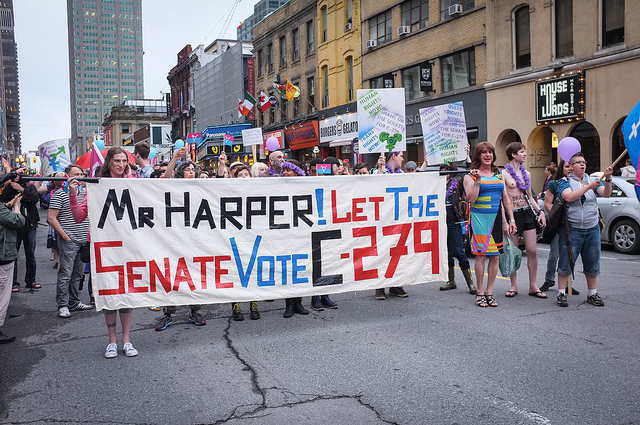Saskatchewan became the first province in Canada to fly the flag of the transgender community on March 31. Though the action is symbolic, it comes at a time where the acceptance of transgender individuals has often lagged behind those of the wider LGBTQ community.
The flag was flown to mark the International Day of Transgender Visibility, meant to promote awareness of the trans community and the human rights issues they still face.
As Mikayla Schultz, Executive Director of TransSask Services, attested that Saskatchewan was the first province to raise the trans flag has sometimes been met with surprised. The province only added explicit protections for transgender persons under its human rights code in 2014, though it had previously described such protections as being encompassed by sex or disability.
Importantly, explicit protections for transgender persons in provincial human rights codes exist unevenly across the country. According to the Trans Equality Society of Alberta, seven provinces and territories offer explicit protection. While human rights commission have nevertheless tended to assert that protection for trans individuals is included under other grounds, the trans community and some legal scholars have concerns that these are insufficient.
Schultz said that while the flag raising may be a small step, it reflects the growing visibility and acceptance of trans individuals.
“It was symbolic of the visibility of the transgender community. How else to be more visible than to have your government fly the flag of the transgender community?” Schultz told rabble.ca in a phone interview.
Schultz pointed out, however, that the flag raising was not the government’s initiative, although she received a certificate of recognition for Transgender Awareness Week from Minister of Justice Gordon Wyant and was pleased to have him speak at the flag raising ceremony.
As well, the politics of LGBTQ flag raising have proved contentious in the past. Efforts to fly the rainbow flag at Queen’s Park during the Sochi Olympics required changes to protocol guides that had mandated the flying of only national or provincial flags. At the same time, then-Mayor Rob Ford also came under fire for opposing the rainbow flag’s raising at Toronto City Hall.
“I don’t mind giving [the government] credit for this event,” Schultz said with a laugh. “It kind of puts the onus on them to improve things in Saskatchewan.”
Schultz highlighted the uneven nature of coverage for sex reassignment surgery (SRS) across Canada, including what she described as low partial coverage in Saskatchewan that relies on reimbursement.
Importantly, the World Professional Association for Transgender Health emphasizes that SRS should be “understood to be medically necessary for the treatment of the diagnosed condition.”
At the same time, there is a divide in the transgender community and among professionals on whether keeping gender dysphoria as a diagnosis is appropriate. In 2013, the American Psychiatric Association released a new version the DSM, the reference manual used to classify and diagnose mental illness, which replaced the category gender identity disorder with gender dysphoria. The change was meant to clarify that gender variance itself is normal while retaining a sometimes applicable diagnosis that ensures access to care.
The variation of SRS coverage in Canada has also proved contentious in the past, with Alberta controversially de-listing the service for two years before re-instating coverage in 2012.
Finally, Schultz highlighted the issue of personal documentation for transgender persons.
“We are in communication on issues of changing gender markers on identification,” she told rabble.ca. “There is some communication but it’s slow coming.”
The Canadian treatment of documentation for transgender individuals gained attention in early 2012 when certain provisions of the Identity Screening Regulations, a component of the Aeronautics Act, became more widely known. Some trans people feared they would be unable to board plans, as air carriers were apparently forbidden to transport anyone who “does not appear to be of the gender indicated on the identification he or she presents.”
Most recently, disagreements over trans rights have been observed in the debate around Bill C-279.
Originally proposed by NDP MP Randall Garrison, the Gender Identity Bill C-279 was meant to provide explicit protection under the Canadian Human Rights Act by including gender identity and gender expression. In its original form, it would have also expanded the definition of an “identifiable group” under hate crime laws.
However, the bill’s passage through the debate has been repeatedly delayed in the Senate due to one of Conservative Senator Don Plett’s proposed amendments. The amendment would controversially exempt sex-specific facilities from its provision and its discussion provoke great debate about public washrooms. Plett’s proposals have sometimes been viewed as a wrecking amendments made in bad faith, as its inclusion would make the overall bill unacceptable for its original supporters.
While multiple flags exist to represent the trans community, the flag flown in Saskatchewan is the most prominent one. It was designed by Monica Helms of Arizona in 1999, with its middle white stripe meant to represent intersex people. In 2014, the original flag was donated to the Smithsonian’s National Museum of American History.
Cory Collins is a St. John’s-based nonfiction writer, visual artist, poet and contributor to rabble.ca and other publications. His poetry, criticism and art work have appeared in The Island Review, Lemon Hound, The Telegram, Burnaby Now, Off the Coast and Cordite Poetry Review, while he has written on current events, economic news and political affairs for Aslan Media, People’s World, Bee Culture and Canadian Dimension. He can be contacted via Twitter @coryGcollins or corycollins.ca.
Photo: flickr/Daily Xtra



